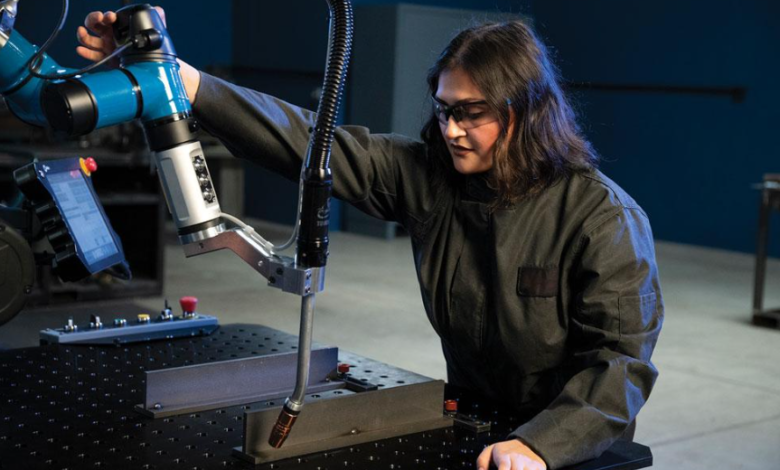Boosting Efficiency and Safety Through Cobot Welding

Cobot welding is revolutionizing manufacturing by boosting both efficiency and safety on production lines. These collaborative robots work alongside human operators, handling repetitive or hazardous welding tasks with precision and consistency, while reducing the risk of workplace injuries. In this article, we’ll explore how cobot welding enhances productivity, improves quality, and creates safer working environments across industries.
Collaborative Cobot (Robot) Welding Overview
Cobot welding is transforming manufacturing by automating welding tasks with precision, safety, and adaptability. It combines a robotic arm, welding tools, and easy-to-use software to deliver consistent, high-quality welds efficiently.
Key Components
- Robotic Arm: Usually a 6-axis or 7-axis arm that moves the welding torch precisely along the joint. Advanced arms can track seams and adjust for complex welds.
- Welding Equipment: This includes the power source, welding torch, and consumables like wire or shielding gas. They provide the energy and materials needed to perform welding.
- Software Interface: Simple interfaces, such as apps or teach pendants, let operators program the cobot easily. Some systems even allow no-code programming for fast setup.
How It Works
- Programming: Operators set the welding path and parameters using the software or directly at the torch for simpler teaching.
- Execution: The cobot follows the programmed path, adapting to variations in the workpiece to ensure consistent weld quality.
- Safety Features: Cobots have sensors that can detect humans or objects nearby. This lets them work safely with people and helps prevent accidents.
Cobot welding makes welding tasks more accurate, safe, and easy to do. It helps workers get more done while keeping the quality consistent.
See also: Wrist-Worn Health Revolution Via Smart Sensor Tech
Boosting Efficiency
Cobot welding systems make manufacturing more efficient by producing consistent, high-quality welds and streamlining workflows. They perform precise, repeatable movements, reducing mistakes caused by human fatigue or variation. Cobots can work continuously without breaks, allowing human workers to focus on more complex tasks and increasing overall productivity.
They also integrate easily into production lines, reduce bottlenecks and downtime, and can safely work alongside humans and other machines. In short, cobot welding improves efficiency, reliability, and overall output in modern manufacturing.
Enhancing Workplace Safety
Cobot welding systems make the workplace much safer by taking on the most dangerous tasks. They reduce workers’ exposure to heat, sparks, and harmful fumes, protecting them from burns and breathing problems. Cobots also handle repetitive or physically demanding work, which lowers strain and prevents fatigue or injuries.
With advanced sensors and safety controls, cobots can detect obstacles and work safely alongside humans, reducing the risk of accidents. They also follow international safety standards, ensuring they can be safely integrated into the workplace without slowing down production.
Flexibility and Adaptability
Cobot welding systems are highly flexible and adaptable, making them suitable for many types of manufacturing. They can be quickly reprogrammed for different welding tasks, handling various part shapes and processes, which reduces downtime and improves efficiency. Cobots work well in both small-batch, custom production and large-scale manufacturing, offering versatility across different production volumes.
They also integrate easily with other automation technologies and Industry 4.0 systems, allowing real-time data sharing, predictive maintenance, and optimized workflows. In short, cobot welding gives manufacturers the flexibility to handle changing production needs while fitting smoothly into modern, connected factories.
Applications of Cobot Welding in Manufacturing
Collaborative robot (cobot) welding systems are transforming manufacturing by improving precision, efficiency, and safety across multiple industries.
Automotive & Aerospace
Cobots are widely used in automotive and aerospace production for tasks like spot welding, seam sealing, and assembling components such as car panels and aircraft fuselage sections. Their high-precision welding ensures consistent quality, reducing defects in critical parts like turbine blades or fuselage sections, where human errors could be costly.
Metal Fabrication & Precision Engineering
In metal fabrication and precision engineering, collaborative robots (cobots) assist with tasks like cutting, welding, and bending metals of different sizes and thicknesses. They handle repetitive work efficiently, letting human workers focus on more complex or creative tasks, which boosts overall productivity.
Construction & Shipbuilding
Cobots are being used more in construction and shipbuilding to weld steel structures like beams and columns, both in prefabrication facilities and on-site. Their ability to safely work alongside humans improves speed, accuracy, and reduces labor costs in space-constrained environments.
Small & Medium-Sized Enterprises (SMEs)
For SMEs, cobots provide a cost-effective alternative to traditional automation. They are more affordable, require less infrastructure, and need minimal maintenance, allowing smaller businesses to enhance production capabilities without major investments.
Cobot welding systems enhance manufacturing across industries by delivering precise, efficient, and safe welding solutions. Their adaptability, reliability, and cost-effectiveness make them a valuable tool for businesses of all sizes.
Challenges and Considerations
Collaborative robot (cobot) welding offers many benefits, and understanding the key factors helps manufacturers maximize its value.
Initial Investment and ROI
The initial cost of a cobot system, including the robot arm, controller, welding equipment, and fixtures, can be quite high. However, the investment often pays off quickly. This makes cobot welding a smart, long-term financial choice.
Training for Operators
Proper training ensures operators can program, operate, and maintain cobots efficiently. It reduces downtime, improves productivity, and allows workers to fully utilize the cobot’s capabilities.
Production Suitability
Cobots are ideal for small to medium batch production and tasks that require precision and flexibility. For very complex or high-volume welding, traditional robots may be more suitable. Evaluating production needs helps ensure the cobot system delivers maximum value.
By carefully considering investment, training, and production requirements, manufacturers can confidently adopt cobot welding.
Future Outlook
Collaborative robot (cobot) welding is set to advance rapidly, driven by artificial intelligence (AI), machine learning (ML), and Industry 4.0 technologies.
AI-Driven Enhancements and Autonomous Operation
AI and machine learning enable cobots to learn from data, adapt to changing conditions, and automatically adjust welding settings in real time. This improves weld quality, reduces defects, and allows predictive maintenance, as AI can anticipate equipment issues to help prevent downtime.
Expanded Human-Robot Collaboration
Cobots are increasingly collaborating with humans on complex tasks such as inspection, assembly, and quality control. This teamwork boosts productivity by allowing humans to focus on skilled, decision-making tasks, while cobots handle repetitive or dangerous work safely and efficiently.
Long-Term Impact on Efficiency and Safety
The long-term impact of cobot welding on efficiency and safety is significant. By handling routine welding tasks, cobots reduce workers’ exposure to risks, increase production speed, and ensure consistent product quality. They also make manufacturing more flexible, allowing companies to adapt quickly to changing demands.
AI and human-robot collaboration are revolutionizing cobot welding. These advancements make manufacturing safer, more efficient, and more adaptable to evolving industry demands.
Conclusion: Embracing Cobot Welding for a Safer, Smarter Future
Cobot welding is transforming modern manufacturing by making welding safer, faster, and more reliable. By taking over repetitive and dangerous tasks, cobots boost productivity, deliver consistent, high-quality welds, and reduce workplace injuries. Their ability to work alongside humans creates a safer, more efficient environment.
Adopting cobot welding gives manufacturers a competitive advantage, helping them keep up with market demands while protecting their workforce. Embracing this technology is a step toward a smarter, safer, and more efficient manufacturing future.



